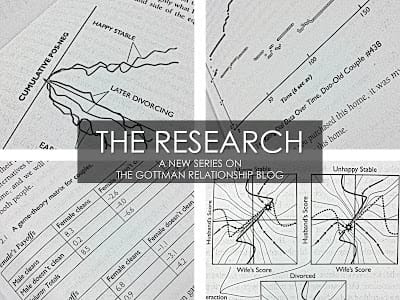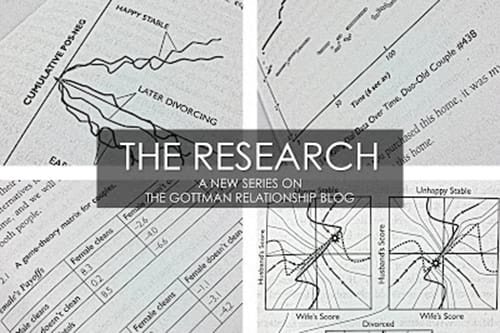
We are excited to announce a brand-new series from The Gottman Relationship Blog! Over the next six weeks, The Research will chronicle the four decades of clinical research performed by Dr. Gottman with over 3,000 couples. While The Sound Relationship House Series offered you insights into Dr. Gottman’s theoretical models and gave you research-based skills to incorporate into your own relationships, The Research will examine exactly how these skills were developed. We will be selecting Dr. Gottman’s most influential studies from the past 40 years, explaining their hypotheses, procedures, and results in a comprehensible, easy-to-understand way.
The Gottman Institute, The Relationship Research Institute, Gottman Method Couples Therapy, and Dr. Gottman’s numerous best-selling books all exist because of Dr. Gottman’s 40-year career as a research scientist whose methods and standards are as rigorous as those used by medical science. The data generated by Dr. Gottman’s research offer a scientifically-based glimpse into the anatomy of marriage and couples relationships. Most importantly, they provide us with factual, objective information that has contributed to the development of tools, methods, programs, products, and services dedicated to helping couples build stronger, happier relationships.
The Gottman Institute welcomes the opportunity to share the insight Dr. Gottman’s research can provide the field of relationship study, and we hope this blog series will provide a greater level of detail and depth to your understanding of our work. In today’s posting, we would like to begin The Research by answering Frequently Asked Questions about Dr. Gottman’s research on couples:
Q: Is Dr. Gottman really able to predict whether a couple will get divorced with 94% accuracy?
Statements about the 94% accuracy rate of divorce prediction have become a source of confusion. People hear Dr. Gottman’s prediction rate is 90 or 85 or 94 percent accurate (depending on the study) and find it amazing, unbelievable, and downright scary. (He often tells his wife that this is why they don’t get invited to more dinner parties!) Dr. Gottman is able say is that a particular couple is behaving like the couples that were in the group that got divorced in his 1992 study (Buehlman, K., Gottman, J.M., & Katz, L.), a study in which Dr. Gottman predicted with 93.6% accuracy which couples would divorce. Look forward to an in-depth explanation of this study in the coming weeks.
Altogether, Dr. Gottman has completed seven studies that explored what predicts divorce. These studies included three groups: 1) couples that divorced 2) couples that stayed together and were happy and 3) couples that stayed together and were unhappy. Dr. Gottman’s research helped him identify specific behavior patterns in couples that he later termed the “Masters” and “Disasters” of relationships.
Although the predictive studies have been touted in the media, Dr. Gottman believes that it’s much more important to understand why certain actions increase divorce risk rather than to predict it. This enables Drs. John and Julie Gottman to design successful interventions. Their very high prediction rate suggests that they’ve hit upon a type of interaction or pattern of behavior that can make a couple vulnerable to divorce – and this sheds light on how best to intervene.
Q: How many divorce prediction research studies and general relationship studies have Dr. Gottman conducted with couples?
Dr. Gottman’s research work with couples started in 1972 and continues today. So far, he has completed 12 studies with more than 3,000 couples. Dr. Gottman’s divorce prediction research specifically (seven of the 12 studies) included 677 couples. These studies were completed at Indiana University, University of Illinois, and the University of Washington.
Q: What research methods does Dr. Gottman use to study couples?
Dr. Gottman and his colleagues brought a multi-method approach to the measurement of couple processes. Methods include:
- Interactive behavior (Coding partners’ behavior and emotions as couples interact in various contexts)
- Perception (Self-assessment through questionnaires, video recall, attributional methods, and interviews)
- Physiology (Measuring autonomic and endocrine systems)
- Interviews (Oral history, meta-emotion, attunement)
- New questionnaires.










